An important event happened this week. Xiaomi proved, albeit with some assumptions, that it could be cooler than Apple. First of all, this concerns the charging station, which the Cupertinians prepared so diligently, but could not release it. And also this week it became known that Huawei is preparing three cool products that should be presented to the world very soon – September 10 this year. All this and much more that was talked about this week and how it will be remembered for you and me, let's discuss in our traditional weekly news collection.
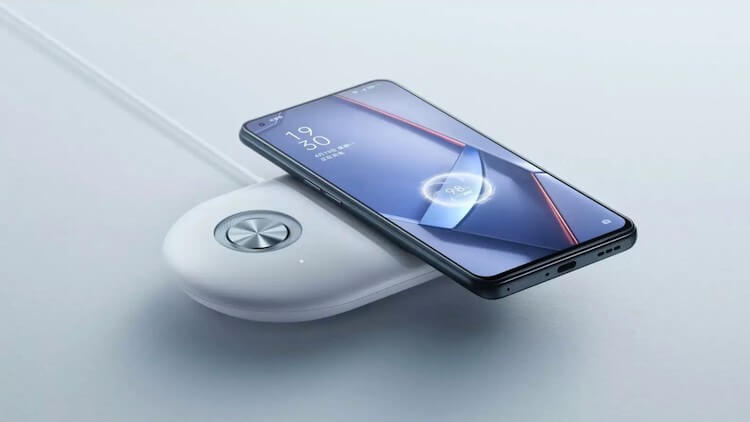
Wireless chargers will be everywhere soon.
How the under-screen camera works Xiaomi
Once upon a time, smartphones did not have a front camera at all, and you could only shoot with the main one. Then there was such a thing as “selfie”, and the front camera became a real “must have” of every smartphone. Even ultra-budget models are simply required to be equipped with it. The problem is that we were shown that displays can be frameless, and now the only problem on the way to full framelessness is that front camera. Some manufacturers have tried experimenting with sliding or folding cameras, but this design takes up a lot of space, which is always lacking inside the case. Time goes by and technology has almost brought us cameras built under the screen. What will happen next, and most importantly, how does such a camera work? Xiaomi gave her answer to this question using her third generation camera as an example.
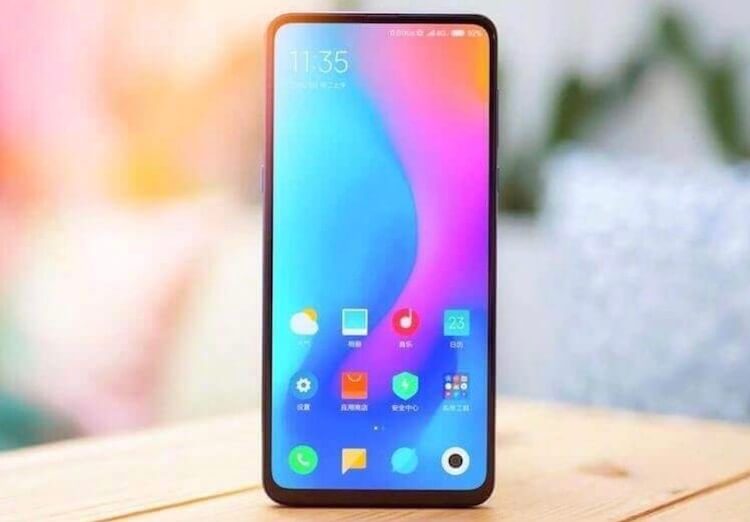
Such a smartphone looks very tempting
It cannot be argued that the sub-screen camera is indeed a big advance in the smartphone market. Companies are working very hard to improve the built-in cameras, but constantly face challenges along the way. It's good that they do not give up trying to make a normal sub-screen camera, because this is the future. If there is no notch or “hole” in the screen, smartphones will become much more attractive, and whoever does this will have a big advantage in the market. His smartphone will look much more interesting and he will be the first to achieve real framelessness.
We already know that ZTE will soon announce the world's first commercial smartphone with a camera in the screen. It will be Axon 20 5G, but Xiaomi didn't want to miss the party and decided to introduce its third generation of on-screen cameras. The company not only showed a working prototype with a new camera on the display, but also showed how the technology has been improved to make it as good as a traditional front camera.
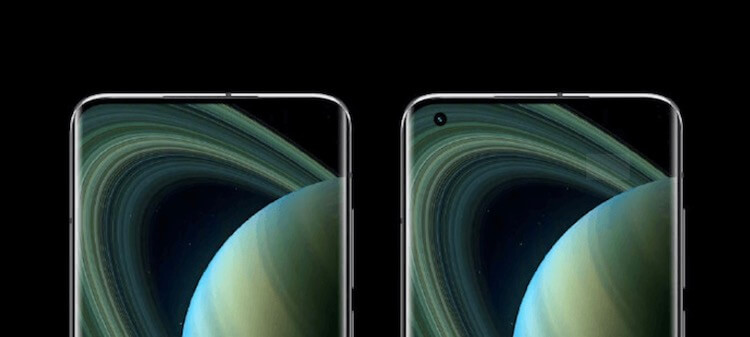
The left option is much nicer than the right one.
The company developed the first generation of screen camera technology in June 2019. We were also able to see a video of the prototype in action, but closer inspection revealed that the display on the top of the camera was not perfect and the pixel density in that area was too low. It was very conspicuous and did not appeal to the finished product.
CEO Xiaomi Lei Jun revealed that the second-generation version of the under-screen camera technology was developed in October 2019. And now he has announced a third-generation version, which, in his opinion, is almost perfect and comparable in quality to a traditional selfie camera.
Xiaomi explained in detail how she achieved “near perfect” camera quality in her third generation of this product. The company said the first two generations have managed to achieve screen transparency above the camera, sacrificing pixel density in that area. In fact, the pixel density was half that of the rest of the OLED panel. The company said in a statement that early versions actually used only one pixel out of every four for the camera to actually capture the image. The rest of the pixels were transparent.
However, the third generation solution solves this problem by using a self-designed pixel layout. Thus, it was possible to achieve light transmission through the subpixel gap area. In addition, the company has doubled the pixel count in both vertical and horizontal layouts to achieve an overall pixel density similar to the rest of the display.
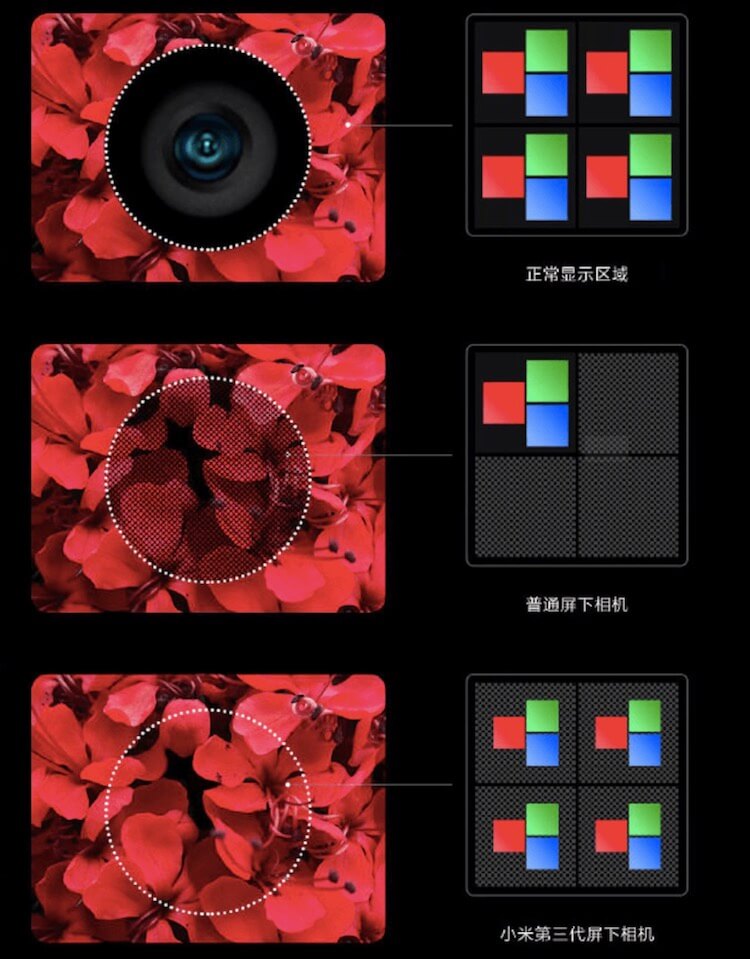
Top Picture – Traditional OLED – Display with 4 RGB subpixels
The middle picture is an early camera display technology that had only 1 pixel.
Bottom picture – all four RGB pixels are working and displaying the picture, providing a high density.
As a result, the display area at the top of the camera below the screen provides the same level of pixel density, color accuracy, color gamut and brightness as the rest of the OLED panel. This is very important for the feeling of the integrity of the smartphone. Otherwise, the solution will be no different from the traditional hole in the screen.
The company has also improved its pixel control circuitry OLED to improve light transmittance above the camera. Finally, Xiaomi claims that her proprietary camera algorithm is capable of delivering the same image quality as traditional front cameras, making her latest solution “almost perfect”.
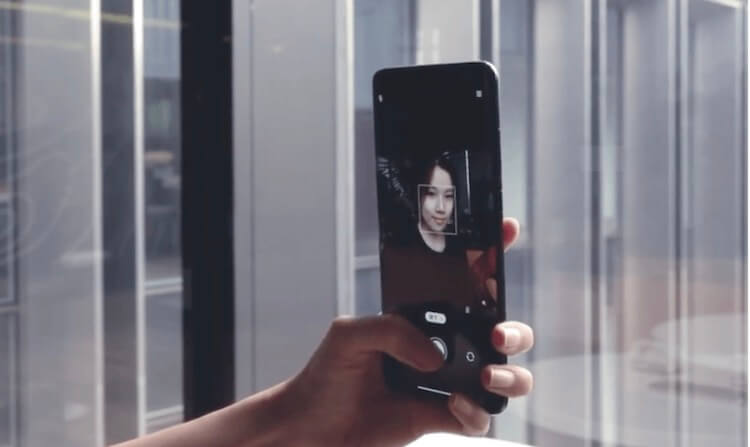
It seems that there is no front camera, but it seems that you can take a selfie.
Xiaomi has never been shy about bragging about her upcoming technology. The company first unveiled its prototype phone with an on-screen camera back in June 2019. More than a year later, we have a video of a working prototype using the third generation of this technology.
In a video posted by Lei Jun on Weibo, the prototype with a camera under the screen looks like a modified Mi 10 Ultra. The video compares the prototype to the standard Mi 10 Ultra, and the increased pixel density above the camera, at first glance, really completely hides the camera under the display.
Lei Jun says the third-generation sub-screen camera solution is ready for mass production and should hit smartphones by 2021. This cannot but rejoice, because other manufacturers will follow in large quantities. But Xiaomi still won't be the first. Already in early September, we will see the ZTE Axon 20 with such a camera. Let's see what happens.
Three new products Huawei
Not everyone knows about it, but there are a lot of products in the model range Huawei. Of course, it is not Xiaomi that taught us that you can equip a house so that every thing will have its logo. However, Huawei is also a Chinese company that is active in the domestic market. Only smartphones (and not all of them), laptops, tablets and literally a few other accessories are delivered to Russia and other countries. Now there is information that the company will show us new products in two weeks, which may be sold in international markets. At least, all the hints that are on the posters of the event speak about this. Let's solve this puzzle and understand what to expect.

Presentations Huawei are always interesting.
I must say right away that you shouldn't count on the appearance of a new Huawei Mate 40. It will definitely come out, but a little later. A separate presentation will surely be devoted to this, since such a product cannot be presented “at the same time”.
The event, which became known, will be held within the framework of the developer conference Huawei Developer Conference 2020. It starts on September 10 and it is on this date that the presentation is scheduled, according to the posters, which hint at new products. This behavior is logical, because many who hold such conferences do this.
For example, Apple at WWDC tells not only about new products in the field of software, but also no, no, and will show something from the “hardware”. True, sometimes they have to wait a long time, but these are details. In the end, it's far from certain that Huawei won't say something like “will be on sale in a month”. Although, judging by the products, you won't have to wait that long.
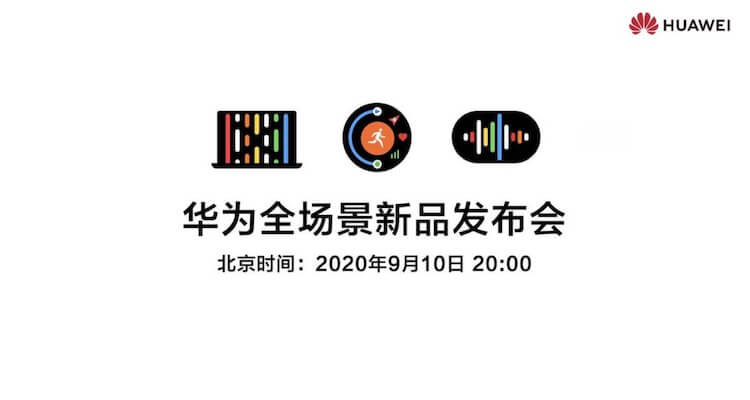
Upcoming presentation poster Huawei.
As seen in the poster posted at Twitter by @ RODENT950, there are three images that are hints at new products. The first is a laptop with a cross, the second is a watch face, and the third is a sound wave.
It is logical to assume that a laptop with a cross may be a new Huawei MateBook X. And here it is not worth remembering that the company has already announced the MateBook X 2020, because this model works on Intel. Knowing Huawei, most likely there will be a Ryzen version, which they can announce at the conference.
The notebook business has become more than just one business for the company. After its smartphones began to experience serious sanctions pressure, the company has to get out. Therefore, it became a very good idea for her to create her own cool computer, which in the future will become part of a strong infrastructure Huawei. With such a product, she can not only make money to survive the crisis, but also diversify her business. It turns out some solid pros for the future.
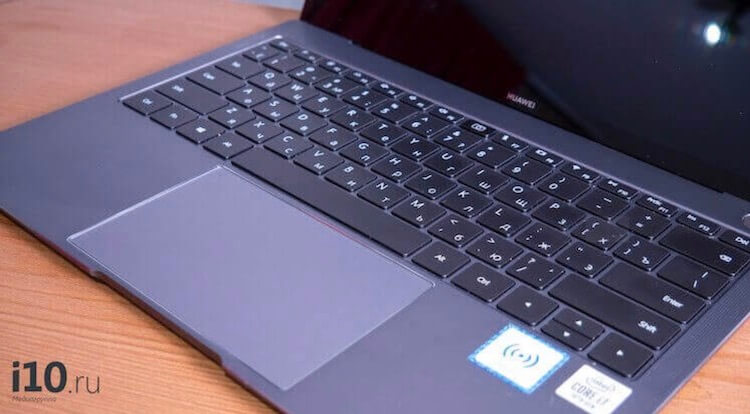
I used this Huawei MateBook X Pro for about a month and was satisfied with everything except the price.
The second image shows the watch face. This is an even more transparent allusion to the emergence of a new product. It is unlikely that we will be shown Huawei Watch GT 3, but Huawei Watch Fit and Watch GT 2 Pro may well. Moreover, it was previously reported that the first will be announced in September, and the second will be launched along with the Mate 40 series. From this we can conclude that September 10 is indeed a great date for the presentation of Watch Fit and Watch GT 2 Pro.
The other day we wrote that Huawei entered the TOP-3 world manufacturers of smart watches, ahead of Samsung. It has nearly doubled its market share to a 9 percent market share, second only to Garmin with roughly the same score Apple, which sells more than half of all smartwatches worldwide. Against this background, the release of a new model would be very helpful.

With the release of this Huawei Watch GT, the manufacturer did everything to correct the mistakes of the first model, and he succeeded.
Finally, the third image shows the sound wave. We do not have a clear understanding of what it will be, but with a high degree of probability we can count on a new speaker with a voice assistant.
In addition, there is a possibility that the company will finally announce the launch of the portable Bluetooth – speaker Huawei FreeGo, which was first talked about back in June this year. If everything goes exactly like this and we are shown one of these columns, then the company will perfectly tighten its infrastructure of gadgets. You understand that now a company that does not make its own speakers (preferably smart ones) is considered, if not second-rate, then at least a little lagging behind.
There is a possibility that, in addition to the speakers, or maybe instead of them, Huawei will announce the launch of its new music service, but for now it is not worth talking about it, since it simply does not need it at this stage of its development.
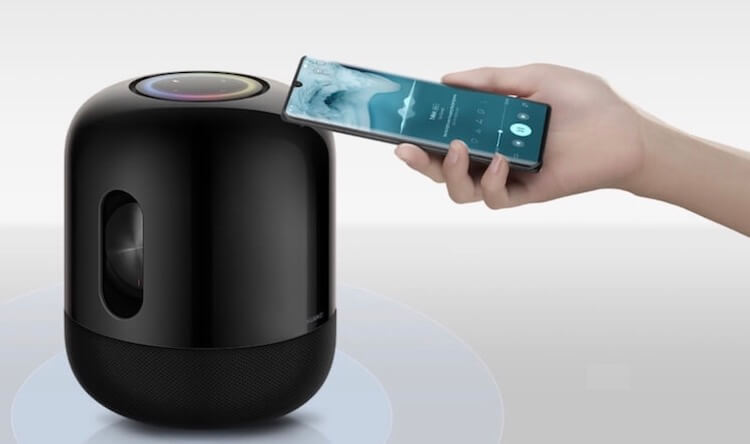
Huawei simply has to make columns.
You should not count on anything outside the listed products. Some little things, like new portable modems and external batteries, can be shown at the presentation Huawei of the Mate 40. If this is something smaller in terms of accessories, then it is not worth wasting presentation time at all and talk about it. It's easier to run it on the site and users will see everything for themselves.
The presentation of the products that the poster is hinting at seems very interesting and intriguing. Although, when a company overcomes difficulties, it is always interesting, because every step is given to it with difficulty and can be a step into the abyss. Then everyone chooses for himself what to expect. Some wonder whether it will fall, while others think whether it will get out. What option are you for? Tell us in our Telegram chat.
Xiaomi invented the ingenious wireless charging
If you've followed the smartphone market a little bit, you've probably heard of AirPower. This is the same charging station that Apple presented in 2017, and two years later, without having released it, was forced to finally cancel it. In Cupertino, they could not achieve the coordinated operation of all induction coils, of which there were about two dozen, and cope with the overheating that they provoked. But the idea was really very successful – the company wanted the smartphone to be chargeable by placing it on any area of the charging station. The solution to the problem, as always, was found by the enterprising Chinese.
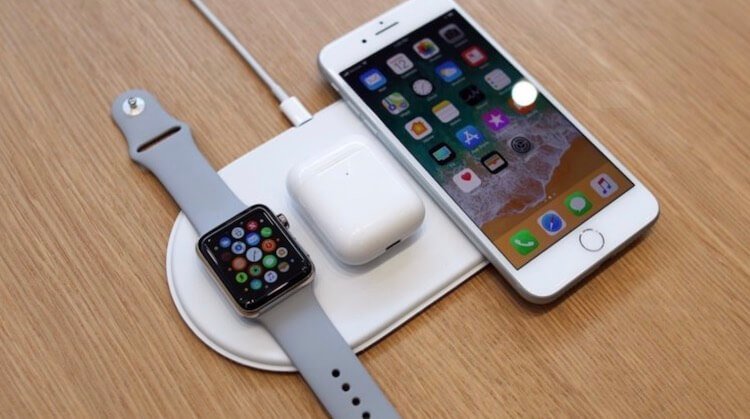
Xiaomi introduced its counterpart AirPower. Almost
Xiaomi introduced a charging station called the 20W Smart Tracking Charging Pad. But its unique advantage lies not in the power output, but in the ability to charge Qi-compatible devices regardless of their location. That is, even if the user places a smartphone or wireless headphones, with which the station also promises to cope successfully, it is uneven, it will not be a problem for it, and charging will start anyway. But how did Xiaomi manage to achieve this?

At first, everyone decided that Xiaomi followed the path Apple and stuffed several induction coils inside the charging station, marking them, at best, overlapping each other, and at worst, just across the entire area. But the Chinese chose a different path, leaving an indication of the peculiarity of the new product in its name. The word Tracking is used here for a reason. It turns out that Xiaomi placed a resistive sensor inside the station body, which determines the position of the charged device, and a two-axis mechanism that moves the coil to the right place.
Considering the station has a 20W output power, it can charge compatible devices quite quickly. That's even more than the included 18W charger for iPhone offers. It charges it in a little more than an hour, which means that wireless charging from Xiaomi will do the same plus or minus. In principle, you still need to take into account the accompanying energy losses, which are inevitable with this method of feeding, but even if they extend charging by 15-25 minutes, it will still be a pretty good result.

This is the same mechanism that moves the induction coil.
Disassembling the charging station showed that under the hood it has only one induction module, which means that it can only charge one gadget, although Xiaomi declared compatibility with two devices at the same time. In principle, it is possible that one coil will be able to load two gadgets at once, but, firstly, this is unlikely, and, secondly, the Chinese promise that the charging device can be placed in any area of the station. Therefore, I can't imagine how the smartphone and headphones will charge if you place them in opposite corners.
Be that as it may, the idea that the Chinese have implemented deserves my sincere admiration. Even if their station can only charge one device at a time, which will be enough for most users, it still allows it to be placed anywhere. And this is the greatest value of this kind of accessories. Yes, the engineers Xiaomi had to take a more complicated path, integrating a movable mechanism inside the structure, but it turned out to be an easier and more efficient way to ensure charging of smartphones and other gadgets without the risk of overheating. In general, like.
Samsung smartphones can be found as iPhone
Despite the fact that iPhone appeared on the market earlier than any other Android smartphone, users of devices based on the OS from Google have always ridiculed their opponents. Their genuine amusement was caused by what they said was a stable lack of features iOS. After all, when an expensive phone does not know how to record video like iPhone 3G, this is a reason, if not for laughter, then at least for sincere surprise. But – I really don't know how it happened – all the most useful functions, for some reason, always appeared first on iPhone, and then they were safely copied by the manufacturers Android – smartphones.
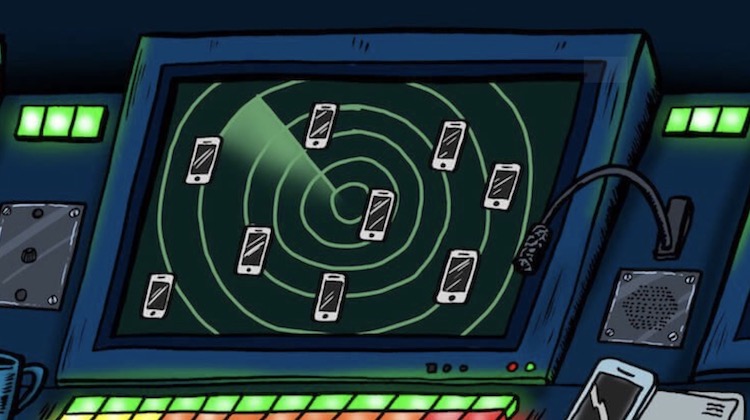
Finding lost Samsung devices made easy
Samsung intends to expand the search capabilities of the Find My Mobile tool, which allows you to track the location of a lost smartphone, eliminating the need for an Internet connection. After all, if earlier, in order to find the device, it was necessary to establish a connection with it via the Network, now this will not be necessary. The Koreans studied the experience Apple and the peculiarities of the 'Locator' tool, which works without an Internet connection, and decided to implement something similar at home.
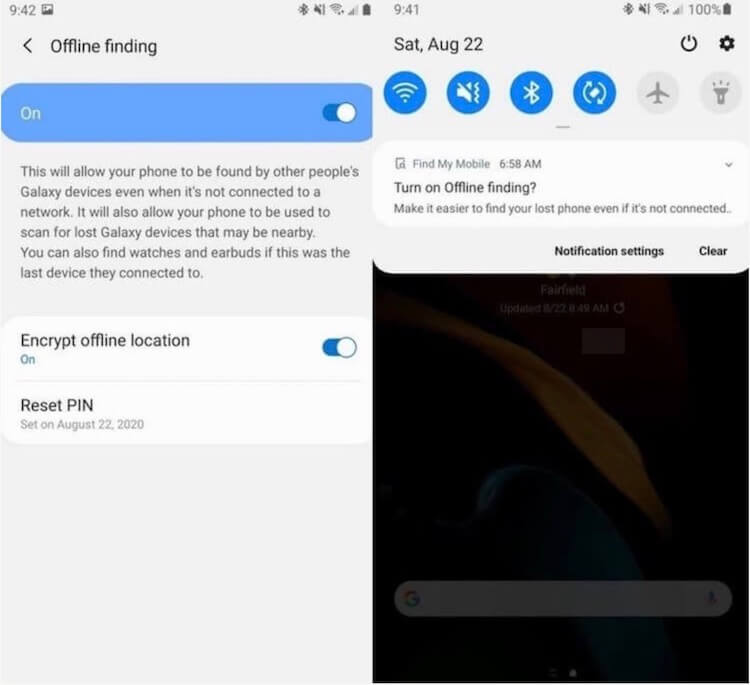
Samsung devices can now be searched even without an internet connection
The updated Find My Mobile tool will work on a crowdfunding model. That is, the smartphone will determine its location based on information from other Samsung smartphones, establishing a connection with them using Bluetooth. Thus, the lost device will be able to transmit information about its location to the device of a passing user, who, in turn, will send it to the owner of the loss. It is very convenient, considering that often those who find a lost smartphone immediately remove the SIM-card from it so that they will not find it.
Samsung has almost completely copied the search model from Apple, applying exactly the same algorithms for protecting lost devices. Thanks to this, Galaxy smartphones that receive the Bluetooth – signal, securely encrypt it and transmit it to the owner of the loss. At the same time, the owners of the devices acting as a signal transmitter can neither see where the lost gadget is, nor even learn about the fact of its use as a repeater. The whole process takes place in a passive mode. And since the connection is established through Bluetooth Low Energy, then the energy is spent on this very little.
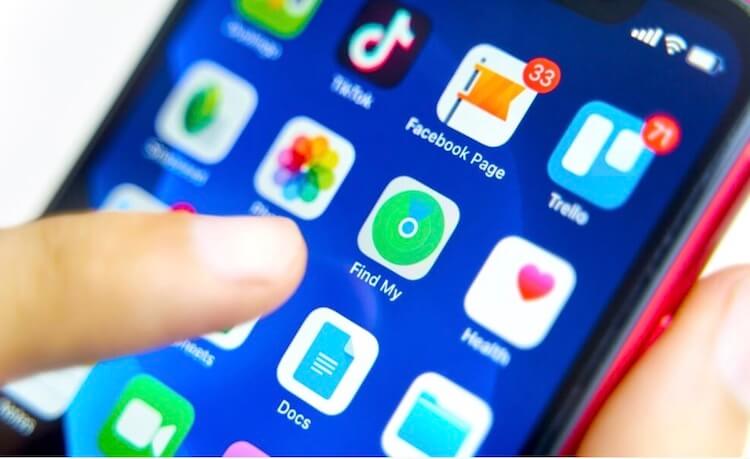
Samsung still has to work and work to achieve the same result in finding missing devices as Apple
But this is not the only innovation of the updated Find My Mobile. Samsung developers also trained a search tool to determine the location of tablets, smart watches, wireless headphones and other Bluetooth accessories. True, the search will be possible only if the smartphone from which the search is performed was the last device to which the gadgets were connected. If this condition is met, it will be possible to find the accessory even if the connection has already been broken.
However, Koreans are still very far from Apple. Despite the fact that they implemented the so-called offline search using the crowdfunding model, they failed to implement the search for discharged Samsung devices. Meanwhile, iPhone and the MacBook have been offering this feature since last year. Developers Apple were able to make their devices keep a small percentage of charge in case of loss. Thanks to this, there will be enough energy for them to be able to broadcast Bluetooth – the signal for a whole month from the moment of complete discharge.
Huawei started updating smartphones 5 years ago
Buying smartphones at Android is a rather compromise step. Even if you buy a flagship device, the best thing in store for you is three years of updates, which only Samsung and OnePlus currently offer. Everyone else has even less software support terms. Xiaomi, for example, even decided to stop releasing updates for their smartphones in the first year of their presence on the market, thus pushing users to purchase a new model. Perhaps this may motivate someone to buy an actual device, but not me, and there are more and more people like me, I must say, lately. It's good that Huawei understood this.

Huawei unexpectedly updated 5 year old Huawei Mate 8
Huawei, which recently lost its license to update its smartphones, did the impossible this week and updated the Huawei Mate 8. This is the device that came out alongside the iPhone 6s. which means that this year he is already five years old.
Neither Huawei nor any other manufacturer has allowed themselves anything like this before and have not renewed support for their smartphones after so long. Despite the fact that so far the update is only available in China, Huawei promised that it will be released in all other countries in the near future.

Huawei added a new smart charging mechanism to the Mate 8 firmware
It is significant that the update released Huawei is not a pass-through patch aimed at eliminating any bugs or vulnerabilities. This is quite a full-fledged update, which includes at least one new feature that is not available even to all new devices.
It turned out to be the Smart Charge mechanism, which allows you to adjust the charging speed depending on how long the smartphone has been connected to the power supply, in order to reduce the load on the battery and extend its life. If you leave the device charging overnight, it understands this and reduces the charging speed. As a result, charging takes 7-8 hours, and the battery reaches 100% exactly by the time it is disconnected from the outlet.
Why Huawei suddenly decided to renew the update of such an old smartphone is hard to say. On the one hand, the introduction of a mechanism that allows you to reduce the load on the battery and extend its life is a relevant step, especially for a smartphone that turns five. It can be assumed that in this way Huawei, as it were, makes the users understand that she remembers them and helps them not spend longer on replacing a worn-out battery.
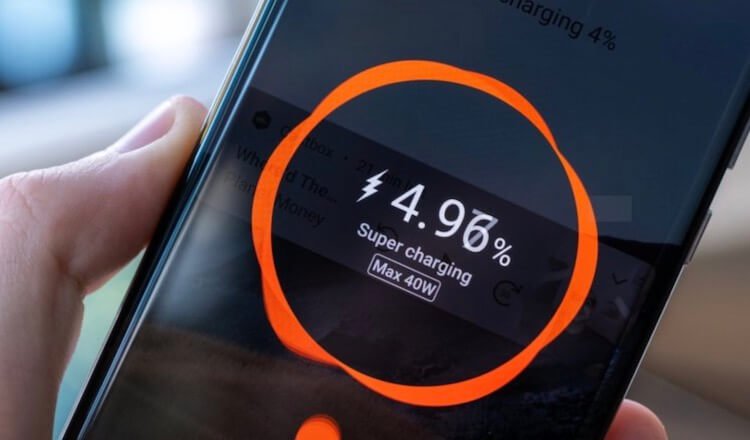
Smart charging helps to delay battery wear
But, on the other hand, isn't it more logical to start implementing the same mechanism in all new smartphones, which Huawei does not yet do in order to preserve their batteries already at the initial stage of operation? In my opinion, this would be much more effective if the goal that the Chinese company is pursuing is really to extend the life of the built-in batteries.
The only explanation I have is the decision Huawei to completely get out of Google's tutelage by following its own rules for updating smartphones. Indeed, despite the absence of an official ban on support for smartphones three years ago and older by the search giant, no other manufacturer has so far dared to continue support after three years.
However Huawei, which was recently finally kicked out of the pantheon of trusted vendors, can now do what it wants, and in my opinion, it could have shown everyone in this way, showing that without Google oversight, its users healed better. . Let for this she had to update the device, which no one uses for a long time.
